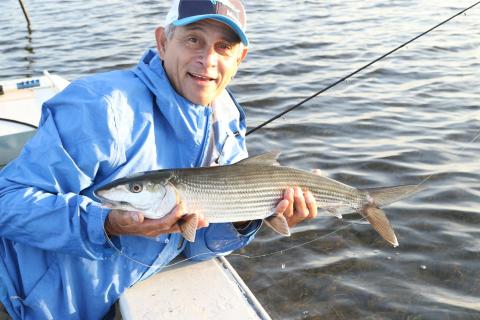
It’s the quintessential case of now you see me, now you don’t; and that uncanny ability to seemingly vanish is what makes bonefish one of the most captivating of inshore sport fishing.The challenge is significant, but these glimmering silver missiles built for astounding speed will deliver an unforgettable engagement well worth the price of admission.
The Admission Fee: It Takes Stealth and Patience to Catch Bonefish
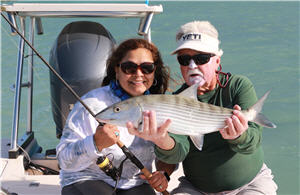
We’ll get to the former in a moment, but for starters, consider the classic bonefish disappearing act: You’ve spotted a group of bones working their way across a flat and carefully eased into an intercept position. You watch them feeding closer, closer, closer; almost within casting range, then —poof!
Gone. No Discussion, No Negotiation; The Bonefish are Just Gone
But how can fish simply disappear? Truth is they didn’t. What happened is the bones changed their angle and those reflective silvery sides accented with faint brown bands allowed them to blend in with their environment long enough to give you the slip. Typically, bonefish will drop into a slightly deeper trough cutting through the flat, or slide into a channel and scoot right past you.
Simultaneously frustrating and exhilarating, this tense challenge keeps anglers coming back for more. Why? Because watching the fastest fish in shallow water sizzle a reel and then admiring the mirror-scaled beauty after a successful fight rightfully holds top-tier status among sport-fishing pursuits.

Tip: Push poling across shallow seagrass flats is the most common way of pursuing bonefish. Keep a baited rod handy for quick response
Anglers Have Two Different Strategies
On South Florida’s shallow, muddy seagrass flats where bonefish feed, anglers have two primary options. We’ll start with the traditional route.

Straight Shank Round
Bend Hook
Stalking the Fish: From a shallow draft flats or bay boat, use a push pole to quietly work your way across the flat, while scanning ahead for what will appear as clusters of dark figures rooting around for crabs, shrimp, etc. Calm, sunny days and glassy surfaces facilitate visibility, but bones become noticeably more jittery when they sense the clarity.
Conversely, a light breeze provides natural propulsion (wind drift), but disturbs the surface. The fish are less visible, but also less nervous. Each day, you fish the conditions, but it’s wise to understand how fish respond.
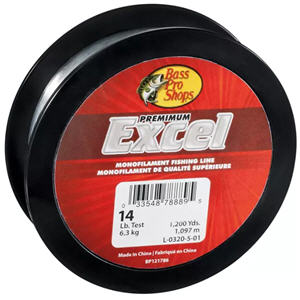
Monofilament Line
Once you spot bonefish, cast a live shrimp hooked through the tail on a 1/0 Bass Pro Shops XPS Straight Shank Round Bend Hook ahead of the fish’s course and lightly twitch/hop it as they approach to ensure someone finds the bait amid the muddy grass. Ideal for this exercise is a 7-foot, 6-inch medium to medium-heavy spinning rod and reel outfit spooled with 10- to 12-pound Bass Pro Shops Excel Monofilament fishing line.
Crimping a Bass Pro Shops Reusable Split Shot Weight about 6 inches above the shrimp adds casting distance, but also increases the sound of a bait hitting the water. Feathering your cast and extending your rod tip right as your bait touches the water helps soften the impact and decrease the fish-spooking noise, but there is another option.

If the split shot is too much for fish in super skinny water, replace it with a 6-inch piece of 32-pound American Fishing Wire Tooth Proof Stainless Steel Leader Wire (dark color) between the main line and hook. The extra weight extends your casting distance, but stretching the additional weight over a longer profile decreases visibility and splash impact.
Tip: Medium to medium heavy spinning fishing tackle will handle most bonefish duties.
Dead Boat: If all that sneaking around’s not for you, select a “bonefishy" spot — fertile flats with deep water close — and stake out the boat by driving the push pole into the mud and roping it to a bow or stern cleat. With long casts, spread four to six lines with fresh shrimp around your perimeter to attract bonefish from all directions.
Good tidal movement helps here, as you want the scent of those fresh baits to travel on the current and point the fish toward your spread. Bones will still eat during slow or slack tide, but for stalking or dead boat tactics, you’ll find the fish considerably more active when the water’s moving.
However You Engage Your Bonefish, Consider These Five key Points
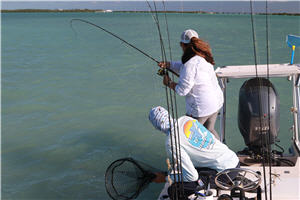
1. Silence Is Golden: It’s not that anyone’s going to jump up and down and blare the radio while bonefishing, but beware the unexpected game killers. When closing hatches or coolers, hold the lid all the way until shut. Drop one lid and that bump will reverberate through the water like thunder.
Stepping around the tight space of a small boat avails many opportunities for toe bumping everything from tackle bags to rods in the under-gunnel holders. Prevent mishaps by arranging gear for minimal impact and carefully planning every step.
Along with this, consider the physics of water displacement. Every time you shift your position in a boat, especially to one side or the other, the movement sends a pressure wake through the water. The impact becomes more profound the shallower you move and if that sudden surge hits a school of bonefish, it’s going to feel a lot like a shark charging in for a meal. The response is usually swift and decisive.

2. Look for Lines: Straining to spot the outline of a complete fish may reward you with an eyeful of silver, but remember, the bonefish is one of the most neurotic fish in coastal waters. As such, it’s not common for them to come close enough for a clear image of narrow nose to forked tail. But, if you learn to spot a fin, a dark back, a tail, you’ll soon connect these pieces to an entire fish — usually with several travel mates.
3. Solar Assistance: Ideally, you want to stalk bonefish with the sun at your back, as this ensure optimal visibility and minimizes glare. Utilizing wrap style polarized sunglasses like Costa Delmar Permit and a hat to block intruding light keeps your vision clean and effective.
The one big consideration that’s easily overlooked by everyone except the bonefish is your shadow. For fish that are keenly aware of their vulnerability to sharks, porpoises and ospreys, dark figures mean trouble. Putting the sun at your rear quarter — rather than directly behind — keeps your shadow off the fish and helps you draw closer to your targets.
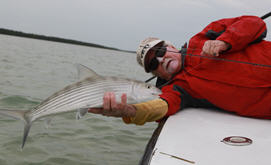
4. Making Scents: It may sound excessive, but thoroughly wash your hands after using sunscreen. Bones can smell any chemical-laden residue transferred to your bait.
Also, live shrimp has a certain smell that bonefish favor over dead bait, so go with what offers the greatest opportunity. Breaking off the tail maximizes the scent output.
Now, these thoughts might lead some to the notion of chumming with cut shrimp. In truth, bonefish certainly will respond to enticing scent trails and a smattering of samples, but so will every catfish, stingray and bonnethead shark in the area.
5. Rod Work: The second a bonefish feels the hook, he’ll ignite the afterburners and blister off a football field of line in seconds. The soft fleshy mouth generally means a solid hook set, but high, steady rod pressure keeps your bone buttoned up. (Make it look like a candy cane and you’re doing good.)
When a hooked bonefish nears the boat, he sees multiple escape opportunities. The motor and staked-out push pole (for dead boating) are easy entanglement points, while dashing under the hull drags your line against an abrasive surface.
Counter your opponent’s efforts by extending the rod away from the boat to keep the fish off the line-breakers, but remaining ready to quickly stick the rod tip in the water to allow maximum clearance. Fight the good fight, grab a quick photo and carefully revive you bone for safe release that helps ensure this magnificent fish lives to challenge someone else.
- 3289 views

